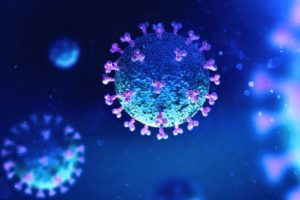今回紹介するBBC放送は、興味深く、参考になります。
まさに世界にとってホットな話題であるコロナウイルスに関して専門家の意見をもとに医学的な解説を行っています。
Introduction
In this programme, we’ll be looking at the origins of Covid-19 and hearing new evidence about the scale of the threat we face from the disease.
はじめに
このプログラムでは、新型コロナウイルス感染症の起源について調べ、この病気から人類が受けている脅威の規模について新しい証言を聞きます。
Covid-19 has changed everyday life for people in countries around the world. But coronavirus wasn’t the first pandemic to cause mass sickness and disrupt daily life.
Covid-19は世界中の国々の人々の日常生活を変えてしまいました。しかし、コロナウイルスは、集団感染を引き起こし、日常生活を混乱させた最初のパンデミックではありませんでした。
Between 2002 and 2004 an outbreak of the disease known as SARS or ‘severe acute respiratory syndrome’ caused hundreds of deaths in southern China before spreading to other parts of the world.
2002年から2004年の間に、SARS、「重症急性呼吸器症候群」として知られる病気が大発生し、中国南部で何百人もの人々に死をもたらして世界の他地域に広がっていきました。
The virus that caused SARS survived by mutating – changing as it reproduced itself in the bodies of infected people and this caused the virus to create strains – slight variations of the original.
SARS の原因となったウイルスは、感染者の体内でそれ自体を再現するように突然変異することによって生き延び、これによってウイルスは、元のウイルスのわずかな変化形である菌株を作り出しました。
Covid-19, the disease caused by the strain of the original SARS virus we are experiencing now, has been called SARS 2.
今私たちが経験しているのが、SARSウイルスの元の菌株によって発症したCovid-19ですが、ときにSARS2と呼ばれています。
The disease spreading across the world today wasn’t the first Covid-19-type disease.
今日、世界に蔓延している感染症は、Covid-19型の最初のものではありませんでした。
In fact a recent research project in China has identified over 700 different types of coronavirus carried by bats. Some of these virus strains are thought to have already crossed over to humans.
実際、中国の最近の研究プロジェクトでは、コウモリが運ぶ700種類以上のコロナウイルスが確認されています。これらのウイルス株の中には、すでにヒトが感染しているものもあると考えられています。
Dr Peter Daszak of New York’s Eco-Health Alliance thinks that new strains of the virus have the potential to cause future pandemics. He spent years in the Chinese countryside looking for the coronaviruses that could jump from bats to humans.
ニューヨークのエコヘルス・アライアンスのピーター・ダスザック博士は、新しいウイルスの菌株に将来のパンデミックを引き起こす可能性が潜んでいると考えています。彼は何年も中国の田舎でコウモリから人間に感染する可能性のあるコロナウイルスを探していました。
Here he is talking to the BBC World Service programme, Science in Action…
BBCワールドサービスの番組「Science in Action」で彼が話しています…。
*************************************************************
Dr Peter Daszak
It would have been great to have found the precursor to SARS 2, but what would have been even better was to have found it before SARS 2 emerged and raise the red flag on it and stop the outbreak. But we didn’t do that. What we were looking for were… at the time … our hypothesis was that SARS 1, the original SARS virus which we all thought had disappeared , was still out there in bats – and that was what we were looking for. So we found a lot of SARS 1-related viruses.
ピーター・ダザック博士
SARS2の前兆を発見できていれば素晴らしいことでした。しかし、SARS2が出現する前に発見して、それにフラグを立てて、流行を止めることができていたら、もっと良かったでしょう。でもそうはならなかった。私たちが探していたのは…。当時、私たちの仮説では、SARS1という、消えたと思われていた原型のSARSウイルスが、コウモリの中でまだ生き続けているのではないかということでした。そうやって、SARS1に関連するウイルスを たくさん見つけたのです。
*************************************************************
Covid-19 may have been contained if scientists had known more about the disease’s precursor – that’s a situation which existed before something and led to the development of that thing. Here, the precursor of Covid-19 was the original SARS 1.
科学者たちがこの病気の前兆についてもっと知っていれば、Covid-19は封じ込められていたかもしれません。それはある状況のことで、何かの前に存在していて、その発症をもたらしたのです。ここでは、コビド19の前兆は元々あったSARS1でした。
Any new cases of the virus would have been a red flag for another outbreak – a symbol of danger and that some action needs to be taken.
ウイルスの新たな事例は、別の感染大流行を示すフラグになっていたことでしょう。フラグとは、危険のシンボルであり、何らかの行動を起こす必要があることを示すものです。
Dr Daszak believed that some form of SARS remained in bats and based his investigations on this hypothesis – an idea which is suggested as a possible explanation of something but which has not yet been proved correct.
Another scientist working to prevent new epidemics is the pathologist Professor Mary Fowkes.
新たな伝染病の予防に取り組んでいるもう一人の科学者として病理学者のメアリー・ファウクス教授がいます。
The original SARS was treated as a respiratory disease which attacks the lungs. But when working with infected patients, Professor Fowkes noticed that Covid-19 was damaging the brain, blood and other organs as well.
元々のSARSは、肺を攻撃する呼吸器系の病気として扱われました。しかし、感染した患者を治療していると、ファウクス教授は、 Covid-19 が脳や血液などの臓器にもダメージを与えていることに気がつきました。
*************************************************************
 Prof Mary Fowkes
Prof Mary Fowkes
Clinicians have recognised that a lot of patients that have Covid-19 are exhibiting confusion, are not necessarily aware of their environment appropriately, some are having seizures, so there are some central nervous system abnormalities. And as you know, a lot of patients are exhibiting loss of sense of smell and that is a direct connection to the brain as well.
メアリー・ファウクス教授
臨床医は、Covid-19に罹患している多くの患者が混乱を示し、必ずしも自分の環境を適切に認識していないことに気づいています。ある人は発作を起こし、ある人は中枢神経系に異常を来しています。ご存知のように、多くの患者が嗅覚の喪失を示しており、これは脳にも直接関係しています。
*************************************************************
In some infected patients coronavirus attacks the central nervous system – the body’s main system of nerve control consisting of the brain and spinal cord.
感染した患者の中には、コロナウイルスが中枢神経系(脳と脊髄で構成される体の主要な神経制御システム)を攻撃するケースもあります。
When severe, this can cause seizures – sudden, violent attack of an illness, often affecting the heart or brain.
重度の場合は、発作を引き起こす可能性があります。発作は、病気が起こす身体への突然の激しい攻撃で、多くの場合、心臓や脳が影響を受けます。
It seems that Covid-19-type diseases are not going to disappear any time soon.
Covid-19型の感染症が近い内になくなることはないと思われます。
Reminding us of the importance of the scientific research we’ve heard about today. And the importance of boosting your immunity.
本日話を聞いてきて、化学研究の重要性がよく分かります。そして免疫の重要性についてもです。
Today we’ve been discussing the strains – or slight variations, of the virus which causes Covid-19. Covid-19 has a previous disease called SARS as its precursor – a situation which existed before something and caused the development of that thing.
本日は、Covid-19の原因となるウイルスの菌株、これはつまりわずかな変異のことですが、それについて議論してきました。Covid-19の前兆として SARSと呼ばれる感染症がありました。この場合の前兆とは、何かの前に存在していた状況であり、その病気の発生を引き起こしたものです
Researchers used the idea that the virus have passed to humans from bats as their hypothesis – possible explanation for something which has not yet been proved true.
研究者は、ウイルスがコウモリから人間が感染したとの仮説を用いました。仮説は、まだ真偽が証明されていないことがそうでないかという説明をする場合に使われます。
By identifying new virus strains, doctors hope unexplained cases can act as a red flag – a warning sign of danger, to prevent further outbreaks.
新しい菌株を特定することで、医師たちは、原因不明の症例が危険の警告サインであるフラグとして機能し、流行の拡大を防ぐことができると期待しています。
- 投稿タグ
- Covid-19



コロナウイルスについてのこの記事は、英語は難しいですが、内容はよく理解できました。新しい型にどんどん変わってきたが、SARSの変形なのだときづいたこと。重症化すると、脳や中枢神経をやられることがあるなど、やはり怖い病気であることを再認識します。このウイルスがなくなることがないとしたら一刻も早いワクチンの開発、治療薬の開発が望まれます
コメントを有り難うございます。世界の歴史を変えてしまったのがこの Covid-19 だと言えるでしょう。
必ずや人類はコロナ禍を克服していくと信じています。